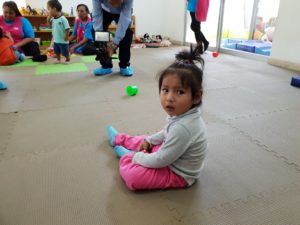Tackling childhood anaemia in indigenous communities in Peru
Three years ago, in the Iguaín Ayacucho region of Peru, 65 per cent of children aged less than 3 had anaemia, putting them at risk of severe long-term effects on health, and impaired cognitive development and school performance. Today that rate has been cut to…
 Three years ago, in the Iguaín Ayacucho region of Peru, 65 per cent of children aged less than 3 had anaemia, putting them at risk of severe long-term effects on health, and impaired cognitive development and school performance. Today that rate has been cut to just 12 per cent, thanks to strong teamwork across many different sectors and particularly the people in the local community.
Three years ago, in the Iguaín Ayacucho region of Peru, 65 per cent of children aged less than 3 had anaemia, putting them at risk of severe long-term effects on health, and impaired cognitive development and school performance. Today that rate has been cut to just 12 per cent, thanks to strong teamwork across many different sectors and particularly the people in the local community.
This success was recognized the award of the 2019 Sasakawa Health Prize at the 72nd World Health Assembly in Geneva. When accepting the prize on behalf of the Peruvian Minister of Health, the director of the ministry’s Office of International Affairs thanked the authorities and the Andean and Amazonian indigenous people of the Iguaín Ayacucho region “for their achievement to prevent the severe long-term effects of anaemia on children’s development.”
Everyone has a role
When the former Mayor of Iguaín, Mr Eusebio Quispe Rodríguez, first received data from the Ministry of Health about chronic infant malnutrition and anaemia in his district, he immediately took action and created a working group to address the issue, recollects Dr Gustavo Rosell from the Ministry of Health, Peru. Municipal, regional and national authorities joined forces to introduce community surveillance centres to tackle this serious health issue.
The work was done by a team of experts in health, education, social protection and law, with a wide range of professionals – nurses, midwives, food industry engineers, anthropologists, social workers, psychologists, doctors, school teachers, computer technicians, lawyers, mayors and town council members.
Community leaders were engaged in the team’s each and every action. What really turned the tide was how local people embraced the initiative.
The health authorities’ main aim was to support families to change their eating habits because, even though the initiative is exclusively focused on children, change in diet can bring health benefits all through the life-course.
#AndinaEnglish Peruvian district wins Sasakawa Health Prize for overcoming anemia in children https://t.co/qtLioDoScr pic.twitter.com/XingFOVtqy
— Agencia Andina (@Agencia_Andina) May 28, 2019
The key to success was the primary health care approach, with the community surveillance teams making home visits to talk with families and working to introduce a new food and nutrition model. This includes teaching and empowering people to improve their diets by consuming locally grown products, such as potatoes, quinoa and corn, some of them fortified with micronutrients provided by the government. The project also provided support to vulnerable people without comprehensive health insurance.
From the perspective of the local actors, interest and support from a wide range of institutions, authorities and partners is vital to prevent, reduce and eradicate anaemia. People working in education, local production of agricultural products and health all must come together for the common goal of improving quality of life.
“I want the entire community to work with mothers, parents and families – the ones directly responsible for children,” says Mayor of Iguaín, Mr Fidel Canales. “We also set ourselves new goals to reach, for instance in different age groups and with different solutions.”
Spreading success
The Sasakawa prize is an enormous boost to the motivation of the technical teams and the community in Iguaín. The teams are already discussing future plans, such as setting up scholarships to allow sharing of successful local experiences, and new projects to address the broad range of causes of poor health.
At national level, the Peruvian government sees this initiative as its commitment to implement the Alma Ata principle of health in all policies. It has endorsed a Multisectoral Plan to Combat Anaemia, which involves all sectors and 15 ministries and is led by the President of the Republic, uniting politicians, media, civil society and, most importantly, citizens across the country.
“This work is not only about health,” says the Mayor of Iguaín Mr. Fidel Canales, “It contributes to the sustainable development of our region.” This has been recognized across the country, as the model applied in Iguaín is being rolled out and replicated in other parts of Peru.
The message from Iguaín is that the district wants to continue to be an example to follow. For the national-level stakeholders, this is also key, as they set very ambitious, long-term goals. Anaemia is a serious public health problem in the country, but if all communities are as committed as the citizens of Iguaín, Peru will indeed be on track to reduce and eventually eradicate anaemia.

© WHO/L. Cipriani
Dr Wieslawa De Pawlikowski, Director of the Office of International Affairs for the Ministry of Health of Peru, accepts the ‘Sasakawa Health Prize’ on behalf of Dr Mr Eusebio Quispe Rodríguez
• Tackling childhood anaemia in indigenous communities in Peru – WHO